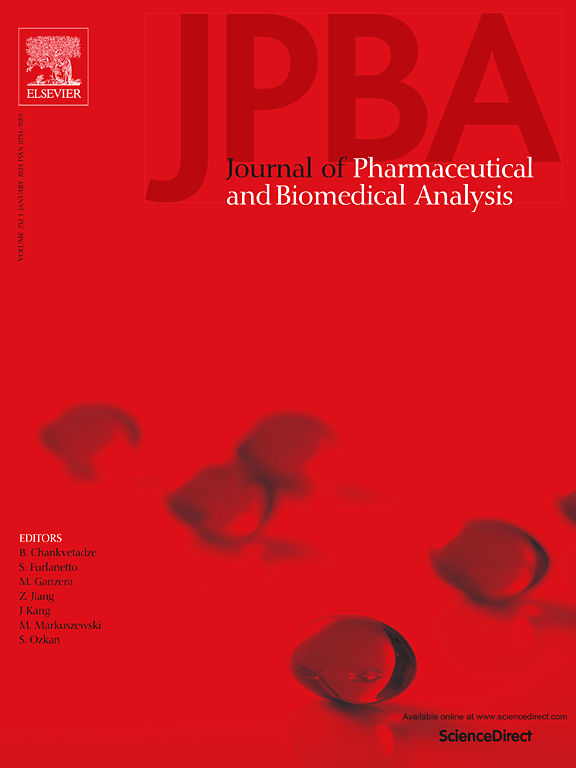用于尿酸和黄嘌呤电化学分析的化学修饰电极的先进设计。
IF 3.1
3区 医学
Q2 CHEMISTRY, ANALYTICAL
Journal of pharmaceutical and biomedical analysis
Pub Date : 2024-10-18
DOI:10.1016/j.jpba.2024.116536
引用次数: 0
摘要
尿酸(UA)和黄嘌呤(XA)是嘌呤代谢的残留物,其中 XA 是 UA 的重要中间产物。UA 和 XA 在维持生物体内生理平衡方面发挥着至关重要的作用。为解决裸电极灵敏度和选择性差的问题,对电极进行化学修饰是一种广泛使用的方法。本文回顾了常用于修饰电极表面以检测尿酸和黄嘌呤的各种材料,重点介绍了可提高电催化活性的特性。我们重点介绍了使用微加工设备的电化学方法检测这些化合物的最新趋势,并探讨了涉及新型纳米材料、碳衍生物、金属纳米颗粒和聚合物的前沿改性技术。综述包括对这些材料的比较分析,探讨它们的优势、局限性和最新进展,如碳基材料和金属有机框架(MOFs)。最后,我们对实际样品中 UA 和 XA 的电化学检测所面临的挑战和未来前景进行了认真研究,并提出了解决这些问题的策略。我们还讨论了在实际样品中测定 UA 和 XA 所面临的挑战。本文章由计算机程序翻译,如有差异,请以英文原文为准。
Advanced design of chemically modified electrodes for the electrochemical analysis of uric acid and xanthine
This study reviews advances in chemical detection methods applied to the metabolic products known as uric acid (UA) and xanthine (XA), which are residues of purine metabolism, with XA being an important intermediate preceding UA. UA and XA play crucial roles in maintaining physiological homeostasis in organisms. Chemical modification of electrodes is a widely used method to address the issues of poor sensitivity and selectivity encountered with bare electrodes. This article reviews various materials commonly used to modify electrode surfaces for the detection of uric acid and xanthine, focusing on properties that enhance electrocatalytic activity. We highlight recent trends in detecting these compounds using electrochemical methods with microfabricated devices and explore cutting-edge modification techniques involving novel nanomaterials, carbon derivatives, metallic nanoparticles, and polymers. The review includes a comparative analysis of these materials, addressing their strengths, limitations, and recent advancements, such as in carbon-based materials and metal-organic frameworks (MOFs). Finally, we critically examine the challenges and future prospects of electrochemical detection of UA and XA in real samples, offering strategies to address these issues.
The challenges associated with determination of UA and XA in real samples are also discussed.
求助全文
通过发布文献求助,成功后即可免费获取论文全文。
去求助
来源期刊
CiteScore
6.70
自引率
5.90%
发文量
588
审稿时长
37 days
期刊介绍:
This journal is an international medium directed towards the needs of academic, clinical, government and industrial analysis by publishing original research reports and critical reviews on pharmaceutical and biomedical analysis. It covers the interdisciplinary aspects of analysis in the pharmaceutical, biomedical and clinical sciences, including developments in analytical methodology, instrumentation, computation and interpretation. Submissions on novel applications focusing on drug purity and stability studies, pharmacokinetics, therapeutic monitoring, metabolic profiling; drug-related aspects of analytical biochemistry and forensic toxicology; quality assurance in the pharmaceutical industry are also welcome.
Studies from areas of well established and poorly selective methods, such as UV-VIS spectrophotometry (including derivative and multi-wavelength measurements), basic electroanalytical (potentiometric, polarographic and voltammetric) methods, fluorimetry, flow-injection analysis, etc. are accepted for publication in exceptional cases only, if a unique and substantial advantage over presently known systems is demonstrated. The same applies to the assay of simple drug formulations by any kind of methods and the determination of drugs in biological samples based merely on spiked samples. Drug purity/stability studies should contain information on the structure elucidation of the impurities/degradants.

 求助内容:
求助内容: 应助结果提醒方式:
应助结果提醒方式:


